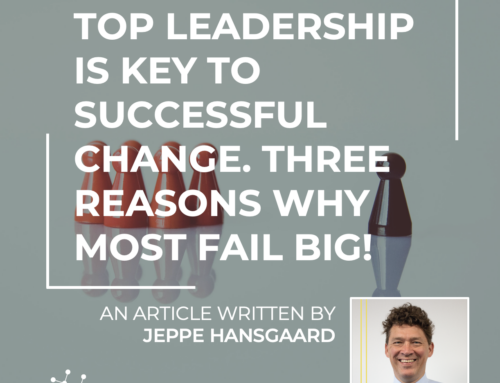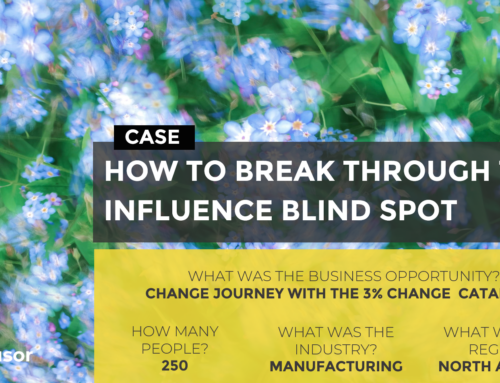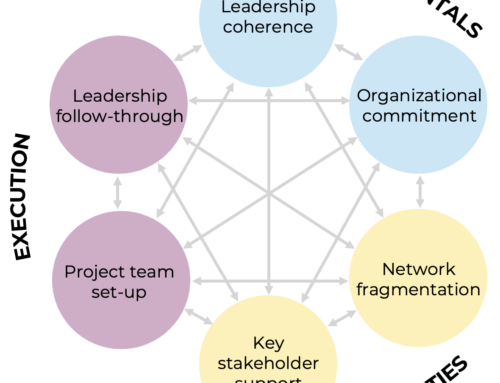Getting 150 People Back on Single Path to Success
They were facing fierce competition and investments were down. It was not like something had to be fixed immediately, but there was a potential waiting to be realized. Now, more than ever, they had to be customer-centric and work together as ONE across its 6 offices and 150 people.
Something they had never excelled at.
They had rather worked as 6 different offices, and in many cases also project team by project team.
No sharing of leads and no sharing of knowledge was the result.
Lower and Lower Win Rates
When a potential new client materialized on the horizon, each team worked the lead on their own without involving anyone else. Causing lower and lower win-rates.
It was clear to the CEO that a new approach was needed.
To put the organization back on a single path.
With upcoming transitions in the leadership team and no immediate changes in the external environment to be expected, he decided to engage Innovisor. The timing was right!
FACT: 150 people is a perfect size organization to showcase evidence-based change impact in 3 months or less.
3 Weeks to Evidence-based Action Planning
Innovisor baselined the organization and its change readiness through the #SixChangeBlockers-intelligence and identified the key opinion leaders (aka the informal catalysts) in the informal networks, and after only 3 weeks moved into helping the CEO and his team to move into action planning mode via an interactive session that took into account unknown constraints previously not considered.
The top leadership team was poorly connected. Sitting in six different offices for years with a sole focus on day-to-day administration and business development has moved them away from each other.
To a place where they were almost internal competitors. Fighting for the same clients – as they actually had done in one case, where the same client got three different offers from the different offices.
Cost-Savings and Hybrid Work
The top leadership had never prioritized social bonding of any kind, and also found it hard to do now. So hard that two of the leaders had to be let go.

Their offices – the two smallest – were closed leading to a substantial and immediate saving of cost.
The employees in the two offices were offered to work from other offices. A one-hour commute away.
100% of the employees in the two offices accepted this offer. Not surprisingly as the baseline of Innovisor showed a very committed and passionate employee group, and a hybrid work option was also allowed.
The informal catalysts were also highly committed and passionate.
Their joint impact was on 94% of their colleagues, who had identified them as trustworthy, knowledgeable and likeable.
Side story: Surprisingly, one of the six informal catalysts was a relative new-joiner who had only been with the company 8 months, but had invested heavily in building social connections with her colleagues. Thus, gained a remarkable informal influence.
Activating Informal Catalysts
The CEO knew he needed the support of this group, as he wanted to steer the organization towards being more customer-centric and working as ONE.
At first he invited them for 1:1 conversations to get to know who they were, their personal priorities and dreams. He listened and listened. The objective was to build trust, so they at a later stage hopefully were ready to engage in the plan.
Following this initial conversation, they took part in a focus group session, where concerns and ideas were shared. It was quickly decided that every single internal process – from recruitment to onboarding, from resource allocation to project delivery, from marketing to proposal generation had to be revamped to ensure the change.

The informal leaders signed up for these initiatives in teams of 2-3 people based on their personal interests, and reported to the CEO and the HR Manager on their progress.
Very quickly – in less than two months – the first improvements were visible and the informal leaders were proud to share substantial improvements in win rates with their peers.
Not through fancy glossy corporate communication, but through the conversation they were already having every day with their colleagues.
Sustaining Change Over Time
Now the hard part was sustaining the changes made. Again, the informal catalysts were great at turning the changes into organizational habits. In a way, nobody could remember one year later that things had ever been done differently before.
A key component in the success of this change was the consistent focus and sponsorship of the CEO. He knew what progress was made – or not made – and guided by Innovisor what he could do to help.
Eg by constantly setting up the project team for success. He continued to have informal coffee chats with the informal catalysts throughout the change, and also afterwards. He had learned that they gave him valuable insights into what was going on in the organization. Input he needed to steer it to success, and input he was not getting from his top leadership team.
Did You Like This Story?
Then follow Innovisor via its newsletter Innovisorize, or on LinkedIn. You can also read similar stories in ‘Another Change Fiasco! Now What?’ and ‘Change is Gridlocked! Now What? – available as eBooks here and in print on Amazon.








